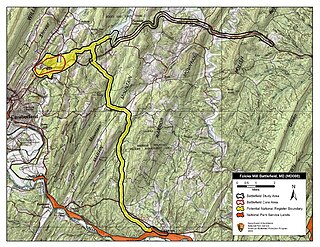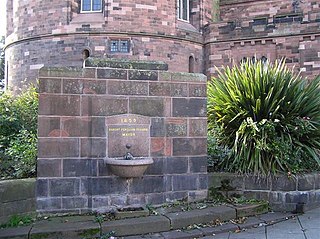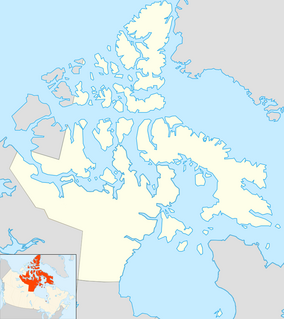
Orleans, is a suburb of Ottawa, Ontario, Canada. It is located in the eastern part of the city along the Ottawa River, about 16 km (10 mi) from downtown Ottawa. The Canada 2011 Census determined that Orleans' population was 107,823. Prior to being amalgamated into Ottawa in 2001, the community of Orleans was spread over two municipal jurisdictions, the eastern portion being in the pre-amalgamation City of Cumberland, the western portion in the City of Gloucester. According to the 2016 census, 69,178 people lived in the Cumberland portion of Orleans, while 47,510 people lived in the Gloucester portion. Today, Orleans spans the municipal wards of Orléans, Innes and Cumberland. Orleans contains a significant francophone minority, although this has been declining in recent decades.

The Battle of Folck's Mill, also known as the Battle of Cumberland, was a small cavalry engagement, fought August 1, 1864, in northern Maryland, as part of the Valley Campaigns of 1864 during the American Civil War.

Cumberland is an incorporated village municipality in the Comox Valley on Vancouver Island in British Columbia, Canada.
Trim Road is an arterial road in the eastern end of Orléans, Ontario. It serves as the only road access to Petrie Island and its public beach in the Ottawa River. From Petrie Island, Trim runs south through the eastern suburban areas of Orleans and then south into rural former Cumberland Township. It travels through the communities of Chartrand and Navan before ending at Perreault Road. It has a total length of 14.4 km (8.9 mi) and connects with Regional Road 174 that connects with Highway 417 further to the west. Its status as a numbered road in Ottawa's city road status ends at Innes Road on the south side of Orleans.
The Cumberland Sound belugas are a distinct population of belugas residing in the Cumberland Sound region of the Labrador Sea off the coast of Nunavut, Canada Individuals of this population reside in the sound year-round, congregating in its extreme north exclusively at Clearwater Fjord during the summer for calving. The Cumberland Sound beluga population is considered fairly isolated and genetically distinct from other beluga populations, with a notable number of haplotypes and microsatellite loci not found elsewhere.

Edward Welby Pugin was an English architect, the eldest son of architect Augustus Welby Northmore Pugin and Louisa Barton. His father was a famous architect and designer of Neo-Gothic architecture, and after his death in 1852 Edward took up his successful practice. At the time of his own early death in 1875, Pugin had designed and completed more than one hundred Catholic churches.
Nimigen Island is an uninhabited Baffin Island offshore island located in the Canadian Arctic Archipelago in Nunavut's Qikiqtaaluk Region. It lies in Cumberland Sound, approximately 10.5 km (6.5 mi) east of Robert Peel Inlet To its east is Utsusivik Island; south is Chidliak Bay.

Robert Ferguson was an English mill-owner from Cumberland, antiquarian and Liberal politician, who sat in the House of Commons from 1874 to 1886.

Akulagok Island is an uninhabited island in the Qikiqtaaluk Region of Nunavut, Canada. It belongs to the Kikastan Islands, located in the Cumberland Sound, off Baffin Island's Cumberland Peninsula. On its south side, Kekerten Harbour lies between Akulagok and Kekerten Island, while to the north lies Tuapait Island. Aupaluktok Island, Beacon Island, Kekertukdjuak Island, Miliakdjuin Island, Tesseralik Island, and Ugpitimik Island are in the vicinity.
Kekertukdjuak Island is an uninhabited island in the Qikiqtaaluk Region of Nunavut, Canada. It is located where the Kingnait Fiord joins the Cumberland Sound, off Baffin Island's Cumberland Peninsula. The Kikastan Islands lie to its southwest. Beacon Island, Miliakdjuin Island, Tesseralik Island, and Ugpitimik Island are in the vicinity.
Miliakdjuin Island is an uninhabited island in the Qikiqtaaluk Region of Nunavut, Canada. It is located southeast of the Kikastan Islands in the Cumberland Sound, off Baffin Island's Cumberland Peninsula. Akulagok Island, Kekerten Island, Kekertukdjuak Island, Tesseralik Island, Tuapait Island, and Wareham Island are in the vicinity.
Tesseralik Island is an uninhabited island in the Qikiqtaaluk Region of Nunavut, Canada. It is located in the Cumberland Sound, off Baffin Island's Cumberland Peninsula, and is one of the islands forming Brown Harbour. Akulagok Island, Aupaluktok Island, Beacon Island, Kekerten Island, Kekertukdjuak Island, Miliakdjuin Island, Tuapait Island, and Ugpitimik Island are in the vicinity.
Tuapait Island is an uninhabited island in the Qikiqtaaluk Region of Nunavut, Canada. It is one of the Kikastan Islands, located in the Cumberland Sound, off Baffin Island's Cumberland Peninsula. To its south lie Akulagok Island and Kekerten Island. Aupaluktok Island, Beacon Island, Kekertukdjuak Island, Miliakdjuin Island, Tesseralik Island, and Ugpitimik Island are in the vicinity.

Beacon Island is an uninhabited island in the Qikiqtaaluk Region of Nunavut, Canada. It lies in the Cumberland Sound, at the mouth of the Pangnirtung Fiord, near Upajjana Island off Baffin Island's Cumberland Peninsula. Akulagok Island, Aupaluktok Island, Imigen Island, Kekerten Island, Kekertukdjuak Island, Tesseralik Island, Tuapait Island, and Ugpitimik Island are in the vicinity.
Ugpitimik Island is an uninhabited island in the Qikiqtaaluk Region of Nunavut, Canada. It is located at the mouth of Pangnirtung Fiord, in the Cumberland Sound, off Baffin Island's Cumberland Peninsula. Akulagok Island, Aupaluktok Island, Beacon Island, Kekerten Island, Kekertukdjuak Island, Tesseralik Island, and Tuapait Island are in the vicinity.
Alexander Petrie and Co was a company that manufactured stationary steam engines. It was based in Rochdale, Greater Manchester in England. The company did general millwrighting, producing some steam engines during the 19th century. Around 1845, their superintendent, William McNaught, was producing large steam-driven beam engines for textile mills in Rochdale.

This is the outline of the geography of the city of Ottawa, the capital of Canada. Ottawa's current borders were formed in 2001, when the former city of Ottawa amalgamated with the ten other municipalities within the former Regional Municipality of Ottawa-Carleton. Ottawa is now a single-tiered Census division, home to 870,250 people.
The Ngugi were an indigenous Australian people and the traditional inhabitants of Moreton Island.









